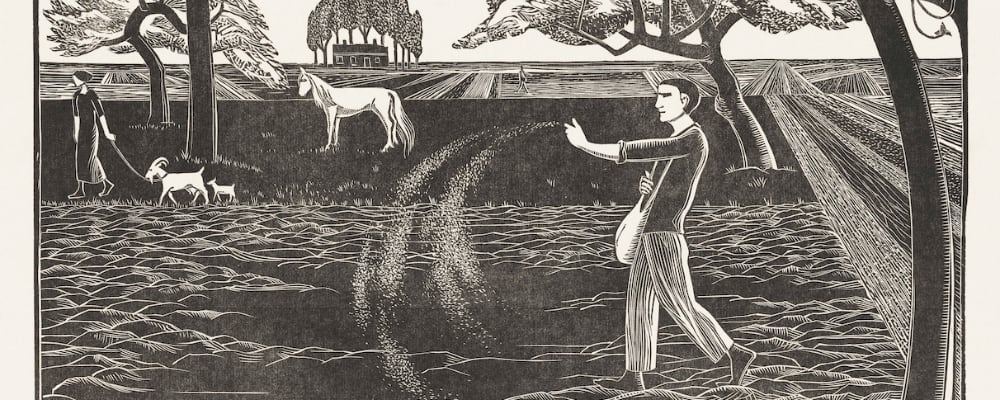In our rush toward progress, what do we choose to keep, and what do we leave behind? This question has been on my mind lately, sparked by a remarkable story from the aftermath of World War I. It’s a story that challenges how we think about value, preservation, and the hidden costs of optimization.
As a young British soldier at the end of World War I, Arthur Watkins stayed behind to help French farmers continue to feed the troops while they waited to return home. Inspired by this experience, he studied and later taught agriculture at Cambridge, where he saw how techniques designed to optimize wheat crops (and profits) also resulted in reducing their genetic diversity. Progress required leaving genes that were of no use behind.
A Trove of Diversity
He then made it his mission to gather as many samples of wheat from around the world as possible, before they were bred out of existence. He succeeded in acquiring 827 varieties from around the globe that have been preserved for over a century. Incredible. Now, as we face accelerating climate challenges, the varieties of wheat we’re using are struggling to adapt because they were optimized for a different planet.
British and Chinese scientists recently collaborated to sequence the genomes of these 827 varieties – resulting in a petabyte of data, which is a thousand terabytes – and found that today’s wheat varieties only use 40% of their traits. This trove of diversity can allow us to create wheat that will continue to feed the world, all because of the forethought of a shy academic who determined that genes others thought were of no value were worth saving.
The Price of Progress
Watkins’ story resonates because it reflects a pattern we see again and again: the way progress often demands we leave things behind, only to discover their value too late. Nearly 70% of silent films have been lost because movie studios didn’t see any value in them. This is a unique and sublime artform – watch the 1927 version of Nosferatu, The General, or Metropolis on Tubi to see for yourself, and consider what we’re missing.
I’m also reminded of how much early Internet content is gone, and along with it a look at how the advent of the World Wide Web created an explosion of creativity and experimentation. This trend is gaining momentum as obsolete media decays and human creations are being supplanted by AI slop: low-effort, low-quality AI-generated content that has begun flooding the Internet. Even the Internet Archive, a bastion of preservation in the sea of relentless progress, is under attack and may not survive.
These losses feel personal because I’ve watched my own relationship with stuff transform over time. I am aware of the importance of letting go of old things as new and better things come along, and realize that lots of people cling to things far too long. It’s tough to embrace change. These days I almost always prefer getting an eBook over a physical copy, even though I love real books and know that what I’m buying is merely a license to read, not an actual book in the form of a digital file (that it often costs as much, or more than a physical book also infuriates me).
When I was younger, one of my favorite things was collecting music and video in various formats. I’d pour over gatefolds and special edition liner notes, displaying my collections on shelf upon shelf in my living room. Now, it, too, is all digital. I’ve made it a priority to minimize the amount of stuff I own, deciding that less is better, but this means I’ve lost something of value as a result.
Cultivating Foresight
So, how can we be more like Arthur Watkins, and know what’s worth preserving?
Awareness
Making thoughtful choices starts with paying attention. When we make a choice to keep or lose something, we need to think carefully about why. Acting as stewards means considering the potential value to future generations. Is this truly replaceable? What assumptions are we making? What’s lost with this removal?
Creating systems that support long-term thinking
Building for the future requires intentional design. Those of us in technical fields can include redundancy and backwards-compatibility in the systems we create. We can create preservation-friendly workflows, decentralize data, and use open formats and documentation.
Learning from indigenous cultures
Looking beyond our own cultural assumptions opens new perspectives. Our culture often has a hard time understanding stewardship, geared as it is toward short-term profits and benefits. Other cultures have taken a broader, long-term view that we can learn from. For example, Amy Bowers Cordalis, a member of the Yurok Tribe in California, has become a climate activist in her efforts to support her tribe’s people and lands. She reminds us that indigenous nations hold 80% of our planet’s biodiversity because they have prioritized sustainability instead of exploitation.
Promoting a preservation mindset
Building community awareness creates lasting change. Evolution may not have wired us for long-term thinking, but we can be taught about its benefits. If a community values the preservation of diversity, it gives us a kind of insurance against an unknown future.
Reviewing our decisions
Taking time to reflect improves our choices. So much is done in the moment, without much thought, because of the need to adapt to new technologies and circumstances. Slowing down and being thoughtful and deliberate about our decisions can make a huge difference in what we choose to preserve.
Mr. Watkins was an outlier whose courage to preserve what others considered worthless may help us tackle our changing world. His story challenges me to think differently about my own choices around preservation and progress. Today we are all stewards of knowledge and resources, making daily decisions about what to keep and what to leave behind. Perhaps by being more thoughtful about these choices, we too can preserve something that will make a difference for our collective future.
